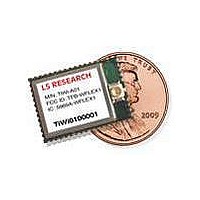LSDEV-WI01-A20 LS Research, LSDEV-WI01-A20 Datasheet - Page 25

LSDEV-WI01-A20
Manufacturer Part Number
LSDEV-WI01-A20
Description
WiFi / 802.11 Modules & Development Tools TiWi RF Dev Kit
Manufacturer
LS Research
Datasheet
1.450-0009.pdf
(31 pages)
Specifications of LSDEV-WI01-A20
Wireless Frequency
2412 MHz to 2472 MHz
Interface Type
SDIO
Modulation
GFSK, CCK, OFDM
Operating Voltage
3 V to 4.8 V
Output Power
12.5 dBm to 20 dBm
Antenna
U.FL Connector for External Antenna (Not Included)
Operating Temperature Range
- 40 C to + 85 C
Lead Free Status / RoHS Status
Lead free / RoHS Compliant
SOLDERING RECOMMENDATIONS
Recommended Reflow Profile
Lead (Pb) Free Soldering Paste
Use of a “No Clean” Lead (Pb) free
Tin/Silver/Copper solder paste is strongly
recommended. Melting temperature 216-221°C.
The soldering temperatures and profile chosen
depends on additional factors such as choice of
soldering paste, size, thickness and other
properties of the host board.
Cleaning
In general, cleaning the populated modules is
strongly discouraged. Residuals under the
module cannot be easily removed with any
cleaning process.
The information in this document is subject to change without notice.
Confirm the data is current by downloading the latest revision from www.lsr.com.
330-0041-Rev2.4
•
•
•
•
•
•
•
•
•
•
•
Note: The quality of solder joints on
the castellations (‘half vias’) where
they contact the host board should
meet
Specification.
Acceptability
Assemblies, section 8.2.4 Castellated
Terminations.”
Ramp up rate (from Tsoakmax to Tpeak)
3º/sec max
Minimum Soak Temperature 150°C
Maximum Soak Temperature 200°C
Soak Time 60-120 sec
TLiquidus 217°C
Time above TL 60-150 sec
Tpeak 260°C
Time within 5º of Tpeak 20-30 sec
Time from 25º to Tpeak 8 min max
Ramp down rate 6°C/sec max
Achieve the brightest possible solder fillets
with a good shape and low contact angle.
the
appropriate
See
of
IPC-A-610-D
Electronic
Copyright © 2010 LS Research, LLC
IPC
Optical Inspection
After soldering the Module to the host board,
consider optical inspection to check the
following:
Repeating Reflow Soldering
•
•
•
•
Consider
soldering paste and thus eliminate
the
completely.
•
•
Only
process
boards.
Cleaning with water can lead to capillary
effects where water is absorbed into the gap
between the host board and the module.
The combination of soldering flux residuals
and encapsulated water could lead to short
circuits between neighboring pads. Water
could also damage any stickers or labels.
Cleaning with alcohol or a similar organic
solvent will likely flood soldering flux
residuals into the RF shield, which is not
accessible for post-washing inspection. The
solvent could also damage any stickers or
labels.
Ultrasonic cleaning could damage the
module permanently.
Proper alignment and centering of the
module over the pads.
Proper solder joints on all pads.
Excessive solder or contacts to neighboring
pads, or vias.
TiWi-R1 TRANSCEIVER MODULE
post-soldering
a
is encouraged
single
using
reflow
a
DATASHEET
cleaning
“no
soldering
for
Page 25 of 31
clean”
host
step














